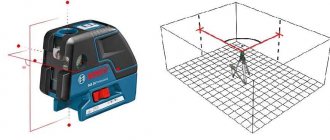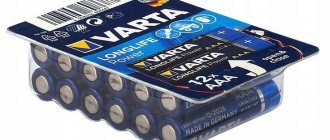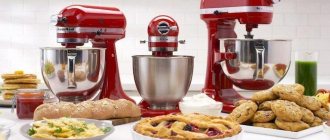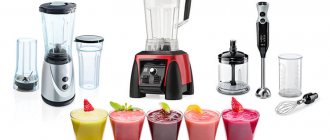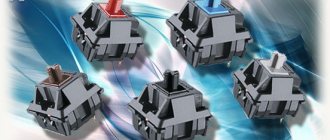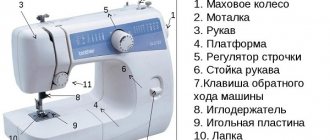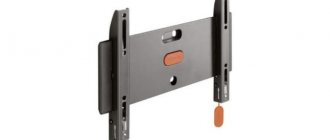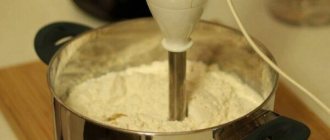What types of home mixers are there?
Mixing devices can be manual, stationary, with a bowl, planetary, for cocktails and their hybrids. There are universal high-power options, which include accessories for all types of products, a stationary platform, containers for dough and cocktails.
Hand mixer
This is a small-sized, lightweight device for whipping and mixing products. A small motor is housed in a compact plastic case. The mounts for the beaters, which are driven by rotation, are brought out from the casing. There is a button to turn on and select a mode (or smooth speed control). Operates from a general power supply network. The set includes 2-4 pairs of attachments. The owner has 5-7 speed modes to choose from. To get started, two identical attachments are attached to the body, and the power cord is connected to the outlet. Then select a mode and press the start button or switch. Power is usually from 300 to 500 watts. Housewives call the advantages of a manual device:
- ease of use;
- ease of care;
- Compact and easy to store.
Mixer with bowl
Looks like a manual analogue on a stand. A removable vessel with a volume of 3-8 liters is attached to the bottom of the stand. The top part of the device folds down. It also has a choice of paired attachments for whipping or kneading. Buttons for turning on and regulating power or selecting speed are conveniently located on the device body. Electronic or mechanical control panel. It is convenient to knead the dough by setting the regulator to long operation. Material of manufacture: plastic or stainless steel. Metal models are more reliable, but more expensive. In stationary devices, the choice of equipment is wider than in manual ones. The kit can include intricately shaped chopping and mixing accessories for a variety of purposes, from juicing to meat processing. Advantage of the device with a bowl:
- less splashing;
- free hands;
- the cook does not get tired from prolonged kneading;
- advanced functionality;
- convenient control panel.
Planetary mixer
This is a stationary model with a bowl and non-standard rotating whisks. The corollas are attached to a disc-shaped base, which also rotates. It turns out that the nozzles rotate along their axis and move along the perimeter of the container at the same time. The planetary system provides improved mixing quality and greater speed of product processing. Ideal for kneading bread or dumpling dough, since there will definitely be no unkneaded areas of the dough. The speed of planetary models is not very high, but the power, on the contrary, is increased. It is advisable to install a stationary beater in a permanent place on an equal horizontal surface.
A device with a reservoir can:
- knead the dough;
- beat the whites to a high foam;
- mix ingredients for mousses, cocktails, desserts;
- chop minced meat.
Cocktail mixer
This is a special device that can only whisk liquid in a tall glass, but it does it better than other models. The body can be made of metal or plastic; tall cocktail glasses are made mainly of stainless metal. They are made on the basis of a hand-held device with a special disk-shaped attachment and a stationary housing for one or several glasses. A hand beater has two whisks that drop into one glass. It is convenient to mix liquid ingredients - milk, syrups, juices, cream. The stationary installation is powerful and is capable of whipping thick, fatty ice cream into foam and even crushing ice into crumbs. These are the machines that whip up milkshakes in cafes and bars. Cocktail making machines are equipped with multi-stage speed control, complemented by a turbo mode for cleaning the whisks.
The principle of operation and structure of the mixer
The direct purpose of this unit is to speed up the cooking process, namely whipping or mixing various products (most often liquid or bulk; for solid products such a unit is of little use, since it uses a whisk rather than sharp blades). The presence of a fairly powerful motor allows you to quickly beat the products and bring them to the desired consistency.
With the help of such a device you can greatly facilitate various tasks in the kitchen.
A typical representative of this type of kitchen appliance is:
- a housing made of hard plastic or in some cases (most often this applies to products in the high price category) stainless steel. The body is made in the form of a cone, to the base of which beaters are attached and the working part on which the beaters are attached. Inside the case, which can be of various sizes (from compact to quite voluminous, taking up a lot of space in any kitchen), there is a small engine that drives the working part (the power of the product is the most important indicator when purchasing and can vary in different ranges), as well as electronics , which is responsible for operation in various modes, a set of fuses that will protect the device from failure in the event of an electrical surge. On the body itself (as usual in the upper part) there is a control unit. This block is a set of keys/buttons that are responsible not only for the correct operation of the device, that is, turning it on and off, but also the operation of various modes, such as intensity, speed, and others, depending on the functional set of the device. Also, in most cases, the body of the mixer is covered with a layer of thin rubber for ease of use (since during whipping the mixer has to be held in your hands and physical force must be used, which can be tiring depending on the duration of work, and the body can also slip out of your hands during prolonged cooking);
The more powerful the motor in the mixer, the more revolutions it can produce - the second part is a nozzle with whisks for whipping products. Most often, this part is separated after cooking and used only before cooking. Therefore, when whipping products, you can use various attachments, either using one large whisk or several small ones, depending on the specifics of cooking. This system allows for more flexible use of the cooking unit. These whisks are usually made of stainless steel, since ordinary steel is highly susceptible to corrosion when it comes into contact with food. Also, when choosing such a mixer, you need to pay attention to the length and number of attachments. The longer the attachments, the deeper the bowl the mixer can be used.
You may also be interested in information about how to properly use a Mulinex mixer with a bowl.
The video shows how the mixer works:
The principle of operation of such a device is as follows:
- Most hand mixers are powered from a standard 220V electrical network. (only a few models have built-in batteries, which, however, cannot ensure continuous operation of the device for more than 40-50 minutes, and also have a correspondingly greater weight, which leads to overwork of a person when preparing food for a long time);
However, we should not forget that with intensive work, the battery will run out very quickly. - After turning on the power supply, you need to lower the mixer into the bowl with the whisk down and select the intensity mode, the speed of movement of the whisks or another additional function and turn on the mixer . The motor drives the whisk and, accordingly, the products are whipped in the bowl. After using the dishes, the whisk must be rinsed under running water and wiped dry (although most models have a stainless steel base, additional care will extend the life of the product).
It may also be useful for you to learn more about how to properly use the Kenwood Chef mixer.
Main characteristics of mixers
Manufacturers indicate several parameters on the packaging of the device: power, material of manufacture, bowl volume, speed modes and the presence of additional functions. Each of these values is important when choosing a home assistant.
Power
Wattage is the rate at which an appliance consumes energy. That is, the rotation speed that the engine imparts to the nozzles. The more powerful the electrical appliance, the thicker the dough it will knead and the more airy the cocktail will be. All other things being equal, a more powerful device is preferable. Average values for a hand-held device are 120-250 Watts, for a stationary one – 300-500. The only negative is energy consumption, which means operating costs increase. In addition, a device with high productivity may overheat during prolonged operation. The instructions for such units specify the maximum time of continuous operation.
Choosing a mixer
When purchasing a mixer, the first thing you should pay attention to is the packaging. It must indicate the country and manufacturing company (preferably with an address and telephone number), the brand of the product, the main technical characteristics, and a barcode must also be applied. In some models, all this information is contained in the product data sheet. There should also be an instruction manual. The passport indicates the warranty conditions, as well as the addresses of service centers or workshops that repair the product.
An equally important indicator that you should also pay attention to is power. The indicator 180-220 W is typical for a hand mixer. For stationary mixers this figure is higher – 270-350 W. High-quality mixers have a speed mode. Different speeds are suitable for different types of work. There are models where the speed is manually adjusted, and some models have built-in buttons to change speeds. In some models, each speed button is accompanied by an explanatory drawing that will tell the owner what speed to choose for which operation. In modern models, a pulse mode is installed, i.e. the speed depends on the force of pressing the lever (button), which is very convenient. But this requires some experience and skill.
When choosing a mixer, you should pay attention to the quality of the attachments. The ideal material for their manufacture is high-quality metal. For low-power devices, the beaters are a wire frame made of metal. More powerful models have much wider blades and, therefore, are more durable. Usually, convenient attachments are sold complete with the mixer, but in addition to this, sometimes measuring cups, brushes for cleaning the mixer, mixing blades, etc. are also offered.
Many mixers are equipped with an attachment release button, and some have a compartment for storing the cord.
In stand mixers, bowl volume plays an important role. It's best when it's big. For example, when beating eggs or cream, the mass increases in volume. In this case, a large bowl will prevent food from splashing or spilling. Here you need to take into account the total volume of the bowl and the usable volume. So, the useful one, as a rule, is much less (about 0.2-0.5 liters).
When purchasing, many people pay attention to the ergonomics of the mixer (a combination of design and convenience). If the mixer is manual, then its weight plays an important role (the mixer should not be heavy, since it will have to be held in your hands), as well as its shape (should be comfortable for the hand).
Additional functions
Manufacturers are expanding the functionality of their equipment in various ways. The mixer may come with a puree attachment, knives, graters, a shredder, a juicer, and even a meat grinder.
Timer
The presence of a timer is important when kneading dough or when strictly following the recipe in complex culinary recipes. Almost all stationary models have such a device. The time counter must be connected to the shutdown function and signal the end of work. When kneading tight dough, this device is necessary.
Overload protection
An indispensable component in powerful planetary dough mixers. The temperature relay will operate if the engine temperature exceeds the temperature limits and the device will shut down. Restarting is possible after cooling down.
Cord storage compartment
A convenient device for winding up excess wires. This is relevant if the device is planned to be stored in a closet or other permanent storage location. Usually located at the base of the device or behind the back wall. Looks like a spiral-shaped channel or protrusion for winding.
Wall mount
A panel for hanging the mixer during storage saves space and helps keep the kitchen tidy. It looks like a plastic or metal mold with holes along the diameter of the main parts.
Models for whipping milkshakes can be permanently attached to the wall. During operation, the device hangs on the wall, and the glass of milk is suspended on special housing mounts.
Rack or box for storing attachments
Some manufacturers provide their products with racks for storing attachments. It looks stylish and neat - all the accessories are in sight and at hand. Does not save space, suitable for a spacious kitchen with a large area of horizontal surfaces.
Milkshake mixer
A milkshake mixer is a stationary device for whipping milkshakes in catering establishments (cafes, bars, cocktail stalls). Is a professional bar equipment. Distinctive features:
- The base of the mixer body is a stand on which an electric motor is mounted on top with a spindle pointing down;
- At the end of the spindle there are one or two rims in the form of small circles-stars;
- Spindle rotation speed 10000-15000 rpm;
- The volume of a cocktail glass is 0.5-1 l.
Mixer attachments
The variety of attachments of modern devices will satisfy the needs of the most sophisticated cooks. There are devices for eggs, creams, dough, sauces. They produce devices for whipping, mixing, kneading, grinding, and grinding.
whisk
This is the basic attachment. Suitable for whipping light mixtures - eggs, cream, milk, omelettes, sweet creams, seasonings. Makes the mass airy and light.
Hook
Spiral hooks are used for kneading sticky dough. They cope with the task better than others, but spend a lot of time on it.
Spatula
Confectioners came up with a spade-shaped whisk for kneading shortbread dough. But it whips up mashed potatoes and mousses just as well. It is most often made of plastic. To beat thick soufflés, release a spatula with a paddle on one side. The mass turns out dense and stable.
Blender
The blender replaces the kitchen machine. May look like a nozzle or container with a lid. It is popular among young mothers, as it simplifies the process of preparing food for the first feeding. A glass with a lid containing sharp knives is suitable for chopping vegetables or nuts. Depending on the material and power of the device, they can even crush ice and grind coffee beans.
Knife
Blender knives come in two types: disc and paddle. A rotary cutter is good for chopping or slicing. A blade knife will finely chop vegetables, boiled meat, berries, and aromatic herbs.
Puree attachment
It looks like a blender, but has holes in the base and plastic blades. In some models, the purée maker is similar to the massage attachment of a hair dryer - plastic pins on a disk base. With this mechanism, the puree turns out to be uniform in consistency and airy.
Sieve
A sieve is used to sift flour before kneading dough or to strain berries, cottage cheese, and fruits. The fact is that when rubbed through a sieve, the products acquire a special airy consistency, which is difficult to achieve with the help of other devices. Wiping by hand is a rather labor-intensive process. Therefore, a sieve attachment can be useful.
Types of kitchen mixers and their scope of application
There are two types of mixers - hand-held and stationary. Manual models allow you to move around the kitchen space and cook in the container you want. This is very convenient when you need to use the device on several work areas or when preparing some complex dish.
It is very convenient to use this type of mixer if the dimensions of the kitchen are small and it is not possible to keep a stationary unit on the work surface. The manual model is easy to care for - the nozzle itself is washable, and the body with the mechanism is simply wiped with a dry cloth. The small size of this device makes it easy to fold and store on a shelf or in a kitchen cabinet.
Stationary mixers are suitable for all those who cook a lot and professionally. The fact is that these devices have a fairly large capacity so that you can not only beat a couple of ingredients, but also knead different types of dough and prepare a large amount of whipped products. This mixer should be placed on a work surface and sufficient space should be allocated for it.
ATTENTION! Models of stationary devices are usually large and have a spacious bowl, the volume of which can vary from one to seven liters.
At the same time, washing them is also quite simple. Always store assembled and use as needed. Stationary models are heavy, solid, suitable for large kitchens. Thanks to their beautiful design, such devices fit well into kitchen interiors of both modern and classic styles.
The convenience of stationary models is that the entire process of beating and mixing products occurs without the participation of the hostess. Just press the button and set the required power. Large quantities of ingredients can be churned in a short period of time. Many people call this mixer a professional assistant in the kitchen. Indeed, there are professional whipping machines that process large quantities of products, bringing them to a homogeneous creamy mass. Bowls in such models are usually from 3 liters.
The professional-grade mixer is made from durable non-toxic plastic, metal, glass (at the bowl) and a plastic body. Of course, the most durable models with metal bowls are easy to care for. It is enough to wash with a non-aggressive detergent using a non-abrasive sponge.
Rules for using kitchen mixers
A kitchen mixer is, first of all, an electrical appliance. Safety precautions are important when handling it. Its service life and operating efficiency depend on how carefully the owner treats the device. When working with a mixer, it is important to follow several rules.
- Safety rules when working with an electrical network: do not touch electrical appliances with wet hands, do not place them on a wet table, do not plug a wet plug into a socket. The electrical appliance must not be immersed in water, washed in a dishwasher, poured liquid on it, or wiped with a cloth that is too wet. Water entering the engine compartment can cause a short circuit. Disconnect and change attachments, clean knives only after disconnecting from the electrical network. If you notice a burning smell from the engine, immediately unplug the power cord.
- Study the manufacturer's recommendations. Every self-respecting factory attaches a brochure to the product, which describes in detail the rules for using attachments, the procedure for turning it on, off, cleaning and storing.
- Use accessories for their intended purpose. Use whisks to beat thin liquids, use dough hooks to knead dough, use spatulas to stir, and use shakers to whip milk and cocktails. You can crush ice, crush nuts and grind coffee beans with specially designed, especially durable attachments.
- Store away from sources of direct fire and elevated temperatures to avoid melting of plastic parts.
- Fill the vessel 1/3 of the total volume so as not to splash yourself and others.
- Start mixing at minimum speed or in the “slow start” mode.
- After finishing work, clean all parts. The attachments are dishwasher safe (unless otherwise specified by the manufacturer). Wipe the case with a damp cloth, paying special attention to the buttons.
How to choose a mixer for your home
The choice depends on the needs of the housewife. What matters is how often you plan to use the device, what dishes will be prepared, the size of the portions, the size of the kitchen, and the budget.
5 steps to make the right choice:
- Device type – manual, stationary, planetary, for cocktails.
- Necessary accessories - whisks, spatulas, hooks, for purees, knives, blenders, graters, choppers.
- Power. For daily use, a manual model with 350-450 watts, and a stationary model with 500 watts are suitable. A planetary mixer is suitable with a power of at least 600W. For regular kneading of dough, choose models from 900 Watt.
- Manufacturing materials. Plastic is cheap, glass is environmentally friendly, metal is reliable.
- Additional features: cord compartments, wall mounting, lighting, overheating protection.
Which mixer is better to choose for home use?
Before choosing an electric mixer for use at home, you need to decide what exactly it can be useful for, what loads it should withstand, what maximum volume of products it can handle, what overall dimensions will be appropriate in the kitchen. After all, it is quite logical that the greater the loading capacity, the larger the size, and along with this the cost also increases. The price category also depends on whether the device is equipped with a set of additional functions; the more there are, the higher the price. And everyone decides for themselves what suits them and whether it’s worth paying more.
Before you decide which mixer to choose for use at home, study their varieties in detail, this will help you avoid wasting money or choosing the wrong configuration. Unit types:
- manual;
- stationary;
- planetary;
- combined.
Each of them has a number of its own advantages and disadvantages, so carefully study the technical data sheet of the model before purchasing.
The best mixers for the kitchen
Ratings of the best mixers are compiled based on customer opinions. On the website of each household appliance store there is a rating of the most popular models and a section for reviews.
Inexpensive manual
In a good hand mixer, buyers want to see average power, ergonomic design and a range of speeds. Ideally, pulse mode or soft start.
- BOSCH MFQ3030
- Power 350W
- Pulse mode
- 4 speeds
- Only positive customer reviews
- Price 1999 rubles.
- SCARLETT SC-HM40S05
- Power 300 Watt
- Bright design
- 7 speeds
- Lightweight and compact
- Price 999 rubles – the lowest in the category
- POLARIS PHM 7016
- 700 Watt power – the highest among hand mixers
- 5 speeds
- Quiet and reliable
- Price 1699 rubles
The best stationary models with a bowl
Among stationary models, high-power devices with a wide range of options are in demand. A large bowl for the dough is also a priority.
- MOULINEX HM 41213E
- Powerful and compact
- 5 speeds
- Capacity 2.5 liters, rotates
- 450 Watt
- The mixer can be removed and used manually
- Unrivaled reliability
- VITEK VT-1415
- Bright design
- Rotating metal bowl
- Power 700 Watt
- Turbo mode
- 5 speeds
- Polaris PHM 8522B
- Steel container
- 5 speeds
- Power 850 Watt
Popular planetary mixers
Planetary mixers are rated by noise level, display and advanced features.
- Bork E800
- Power 1000 Watt
- Stainless steel housing
- Timer and sound signal
- Lots of attachments
- overheat protection
- Digital display
- Large bowl 4.7 liters
- Silent
- Endever Skyline SM-10
- Power 600 Watt
- Stainless steel housing
- Capacious capacity 4 liters
- Large number of attachments
- Vitek VT-1406
- Power 700 Watt
- Turbo mode
- Steel vessel
- Affordable price
The best dough mixers
When kneading dough, the power of the device, the presence of special attachments, a timer with a shutdown function, and protection against overheating are important. With prolonged kneading and frequent use, these factors play a big role.
- Bork B810
- Power 1000 Watt
- All steel
- Speed indicator
- Display
- Timer with countdown and sound signal
- 4 types of whisks
- Capacious capacity 4.75 liters
- Overheat protection and self-diagnosis
- Sinbo SMX 2739W
- Power 800W
- Stainless steel bowl
- 3 different attachments
- Display
- Countdown timer
- Smooth start and speed control
- Planetary
- Gemlux GL-SM10GR
- Power 1500W
- Capacity 10 liters
- Timer
- 4 types of attachments, convenient double dough hook
- All metal
- Display
- Planetary rotation
